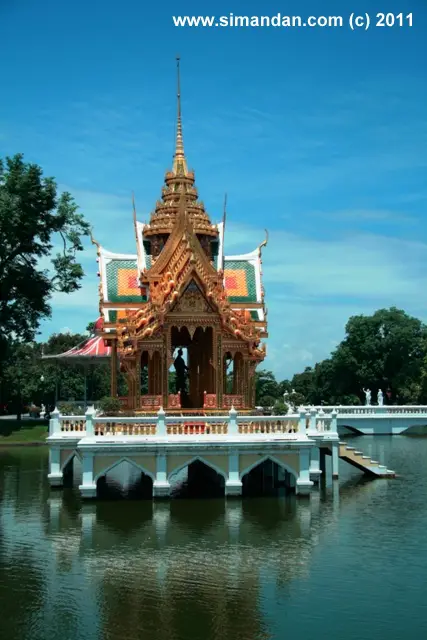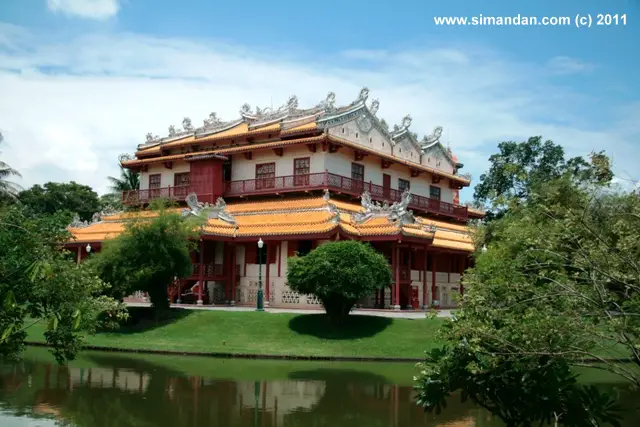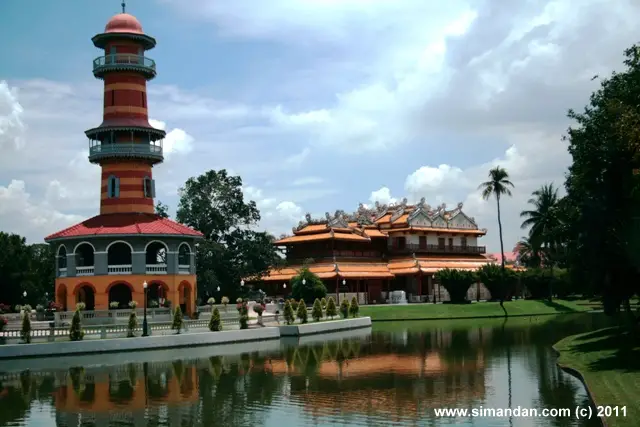 It makes me angry when I see people and mass media label a tourist location with the worst possible connotation. I mean, more than often, Bangkok is referred to as “The Sex Capital of the World” (an exaggerated generalization that is actually not accurate) rather than “The City of Angels” (a shortened form of the official name of the capital). Unfortunately, this happens not only in the international press, but also locally. If you ask the Thais to give you a short description of Bang Pa-In, one of the 16 districts from Ayutthaya Province, they’ll most likely say “antalai mak mak,” which means “very dangerous” and it refers to the many drug gangs that operate there. If you ask me, a foreigner living in Thailand, I’d say Bang Pa-In is the place where the Royal Summer Palace is located. Can you see the difference in our perspective?
It makes me angry when I see people and mass media label a tourist location with the worst possible connotation. I mean, more than often, Bangkok is referred to as “The Sex Capital of the World” (an exaggerated generalization that is actually not accurate) rather than “The City of Angels” (a shortened form of the official name of the capital). Unfortunately, this happens not only in the international press, but also locally. If you ask the Thais to give you a short description of Bang Pa-In, one of the 16 districts from Ayutthaya Province, they’ll most likely say “antalai mak mak,” which means “very dangerous” and it refers to the many drug gangs that operate there. If you ask me, a foreigner living in Thailand, I’d say Bang Pa-In is the place where the Royal Summer Palace is located. Can you see the difference in our perspective?
Bang Pa-In Palace, located about 60 kilometers north of Bangkok in the Ayutthaya Province, is a well-maintained tourist destination with a fascinating history. It’s vicinity to the capital and another major tourist attraction (the City of Ayutthaya itself) makes Bang Pa-In the perfect place for a one-day trip.
The history of Bang Pa-In Palace goes back to the 17th century when, according to a chronicle of Ayutthaya, King Prasat Thong had a palace constructed on Bang Pa-In Island in the Chao Phraya River. The story goes that King Prasat’s father, King Ekathotsarot, was shipwrecked on that island and had a son by a woman who befriended him (the future King Prasat Thong).
After the fall of Ayutthaya in 1767 as a result of the Burmese army’s successful invasion, the palace was probably not inhabited anymore. It remained so for a long period of time. In 1807, Sunthon Phu, the Kingdom’s best known poet, sailed past Bang Pa-In and wrote that the site was neglected and overgrown. The palace was revived by King Mongkut of the Chakri Dynasty, setting the pace for further construction and improvements.
Today, the palace is under the administration of the Bureau of The Royal Household and is used occasionally by the royal family as a residence and for holding receptions and banquets. Similar to most Thai royal palaces, the compound is divided into two sections: the Outer and Inner Palace. The Outer Palace consists of buildings for public and ceremonial uses, while the Inner Palace is reserved for the royal family. Formerly, the Inner Palace was forbidden to male members of the court.
As you enter the grounds of the palace through its main (and only) entrance, you’ll have to pass the Ticket and Information Office. There is a 100 Baht entrance fee and the palace stays opens daily between 8:30 and 12:00 and 13:00 and 16:00. Once inside, you have two choices: visit the palace on foot or rent a golf cart. My advice is to go for the golf cart if you’re accompanied by children or elderly as the place is quite big.
Navigation inside the palace grounds is easy. All you have to do is follow the well-maintained paved path and, at major crossroads, consult the maps on display. The first structure that will attract your eye is Ho Hem Monthian Thewarat, a small stone Khmer-style prasat. According to folklore, a prasat is the residence of a king or god. This particular one was built by King Chulalongkorn in 1880.
As you reach the first of the many bridges that you’ll have to cross on the palace grounds, you will notice, in the middle of a pond, one of the most famous Thai-style pavilions. It is called Phra Thinang Aisawan Thiphya-Art, which translates as “The Divine Seat of Personal Freedom” and consists of four porches and a spired roof. This pavilion now houses a bronze statue of King Chulalongkorn in the uniform of a Field Marshal.
One more bridge later and you’ll find yourself in the Inner Palace, where you can circumnavigate the Royal Residence. The original building was accidentally burnt down in 1938, but it was rebuilt before the turn of the millennium. The only part of the original structure still in existence is the water tank, disguised as a crenellated Neo-Gothic tower. An observatory nearby offers you the chance to have a panoramic view of the entire palace complex and, even further, the surrounding countryside.
For me, the most striking building in the entire complex is Wehart Chamrun, a Chinese-style two-storey mansion. It was built by the equivalent of the Chinese Chamber of Commerce and presented to King Chulalongkorn in 1889. The ground floor contains a Chinese-style throne among other pieces of décor and art. Taking photographs inside this temple-like building is forbidden, but good quality postcards are available for sale at the Information Office.
On both sides of these main buildings, located right in the middle of the palace grounds, there are many more smaller houses that, in the past, served various different purposes. Some of them are now open for the public, while others can be admired from the outside only.
Still, another place worth mentioning, and definitely worth stopping at, is the Memorial to Queen Sunanda Kumariratana. The story behind this four faced structure is very tragic: in 1881, the Queen and her only daughter were on their way to the Bang Pa-In Palace when the royal barge carrying them capsized. According to Thai law at the time, touching a royal was punishable by death, so the royal retainers looked on helplessly as they drowned. Even more shocking, they were instructed to do so by a guardian on another boat.
If the sky is clear and it’s not the rainy season, a trip to Bang Pa-In Palace is a wonderful photo opportunity. Apart from the natural richness of its surroundings, a good map-brochure will also help you keep informed regarding all the historical and religious significances that each building carries.
The easiest way to reach the palace is to drive there by yourself. All you need to do is get on the Bangkok-Chonburi motorway and follow the signs. They will take you straight to the entrance gate. If you’re already in Ayutthaya, you can take a van from Chao Phrom Market or, if you’re in Bangkok, go to the Northern Bus Terminal (near the Chatuchak Weekend Market). There are also river tours available directly from Bangkok, but you’ll have to contact a travel agent to book one.
Initially published in ‘Bangkok Trader’ (vol.5, no. 4, March 2011)



